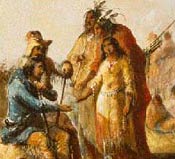Shoshone Indian (c. 1790-1812 or 1884)

Sacagawea was a legendary figure in the history of the American West because of her indispensible role on the Lewis and Clark Expedition.
She was the daughter of a Shoshone chief who was kidnapped by the Hidatsa when she was about ten years old. She was living in their village on the upper Missouri when she and another captive girl were purchased and wed to a French Canadian trapper by the name of Toussaint Charbonneau.
In 1804, when Lewis and Clark engaged Charbonneau as an interpreter for their expedition, it was with the understanding that Sacagawea would also accompany them. Her value to them was not just as another interpreter but as an amabassador of sorts to Indians they would encounter along the way. Clark described her presence in his journal this way: “a woman with a party of men is a token of peace.”
Eight weeks before Lewis and Clark set out from the their encampment, Sacagawea gave birth to her first child, a son named Jean Baptiste Charbonneau. Clark referred to the child as “Pomp” or “Pompey”. The expedition called the “Corps of Discovery” headed upriver in April, 1805 with Sacagawea carrying her infant on a cradleboard.
Four months into their travels, when the expedition had reached the navigable limits of the Missouri, Lewis made contact with a Shoshone Indian band. He was hoping to secure horses to help them cross the mountains. When Sacagawea arrived as interpreter, she discoverd that the band was led by her older brother, Cameahwait, who had become chief on their father’s death. Despite having a clear opportunity to use this happy reunion as a means to return to her people, Sacagawea instead helped Lewis and Clark secure the horses they needed and then continued as their interpreter-guide forward to the Pacific.
On the return journey, Sacagawea and her husband Charbonneau separated from Lewis and Clark at a Hidatsa village on the upper Missouri. It is at this point in the the historical record that little is known of their lives.
Charbonneau traveled to St. Louis at the invitation of William Clark, who had grown fond of Charbonneau’s young son, and tried to induce Charbonneau to settle there. The visit proved not to be too successful, though, as Charbonneau soon returned to trapping, leaving son Pompey in Clark’s care. Charbonneau worked for the American Fur Company.
It is not known whether Sacagawea accompanied her husband to St. Louis. Some evidence indicates that she did then returned to the upper Missouri with her husband where she died in late 1812 during an epidemic of “putrid fever”. Other accounts say that Sacagawea ultimately rejoined the Shoshone on their Wind River reservation and died there in 1884.





